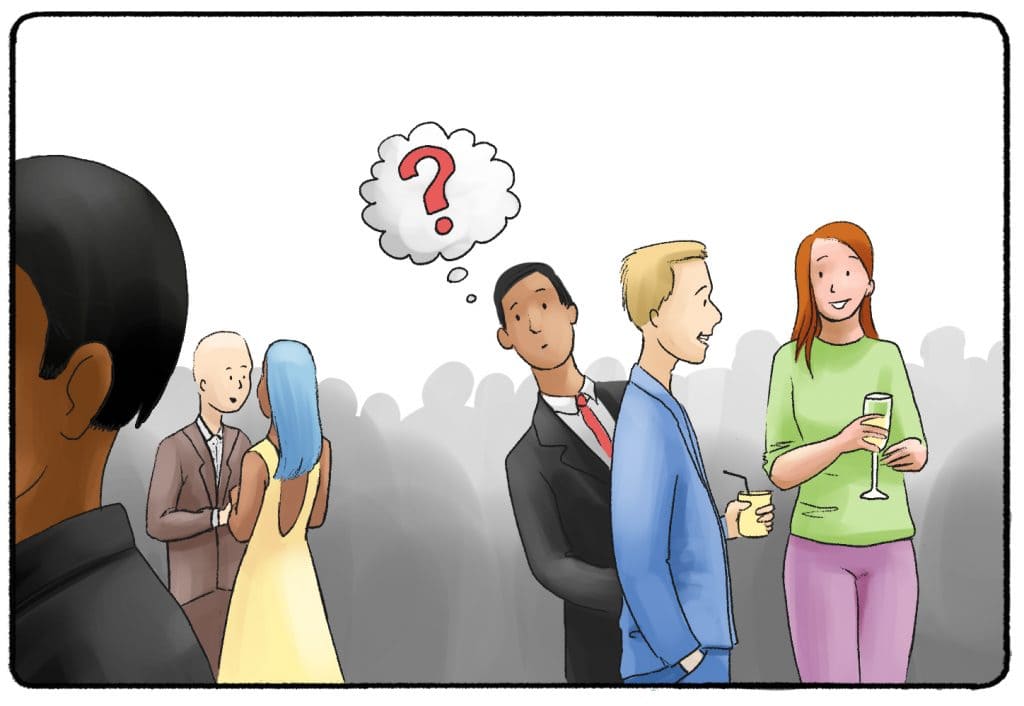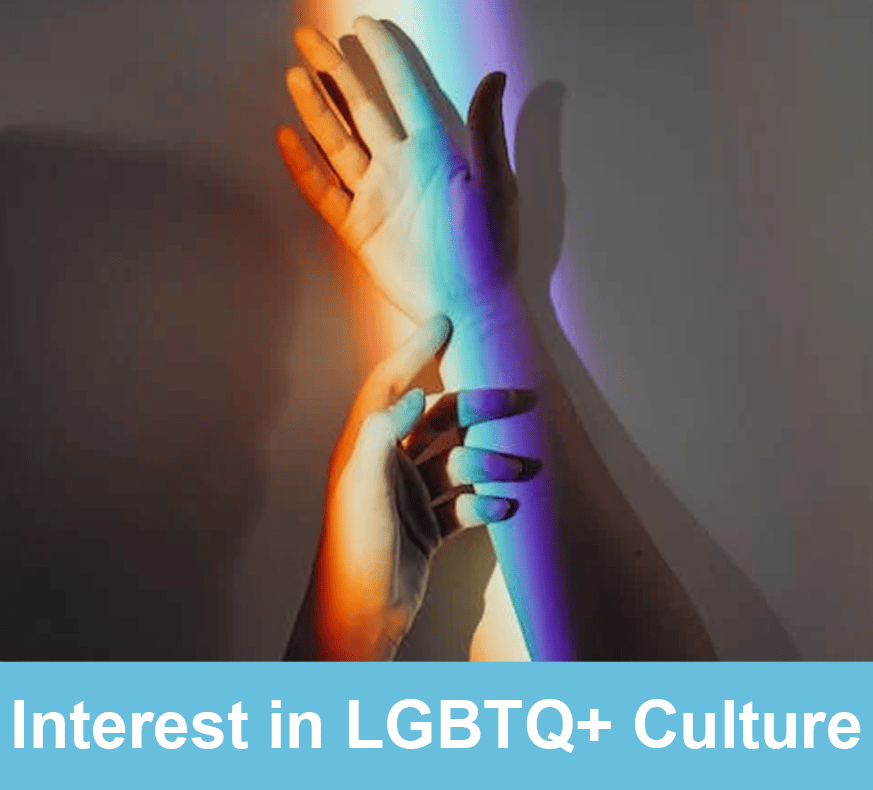In today's society, the journey to self-acceptance and coming out as gay can be a complex and challenging process for many individuals. While there has been significant progress in LGBTQI+ rights and acceptance, there are still instances where people feel the need to hide their true selves. As such, recognizing the signs a guy is pretending to be straight can help understand and support those grappling with their identity. This article will explore 17 signs someone is gay, even if they're trying to present a heterosexual image.

Knowing how to identify the signs a guy is pretending to be straight can offer valuable insight into a person's struggle with self-acceptance and the pressures they may face from societal expectations or personal circumstances.
By exploring various signs someone is gay, ranging from subtle cues to more overt indicators, we hope to foster empathy, understanding, and support for those who might be wrestling with their sexuality.
1) Overcompensating with Masculine Behavior
One common sign that a guy might be pretending to be straight is overcompensating with masculine behavior. This can be seen when a man exaggerates traditionally masculine traits or activities in an attempt to appear more "manly" or assert his heterosexuality. He might engage in extreme sports, heavy weightlifting, or aggressive competition, even if these pursuits don't interest him. By doing so, he hopes to divert attention away from his true sexuality and present an image that aligns with societal expectations of a straight male.
This overcompensation can be rooted in a psychological defense mechanism called reaction formation. Reaction formation occurs when an individual experiences unwanted feelings or thoughts and responds by adopting the exact opposite attitude or behavior. In the case of a guy pretending to be straight, he may be trying to mask his true feelings of attraction toward other men by acting overly masculine or expressing a strong interest in women.
This behavior can serve as a protective barrier, helping him hide his true identity from others and himself. By understanding the reasons behind this overcompensation, we can better empathize with those struggling to accept their true selves and provide support during their journey toward self-discovery.
2) Exaggerated Interest in Women
Another sign that a guy might be pretending to be straight is displaying an exaggerated interest in women. This can manifest as frequently talking about women, making sexual comments, or boasting about past romantic or sexual encounters. By engaging in these behaviors, the individual aims to convince others, and possibly himself, of his heterosexuality.
For example, a man who is hiding his true sexuality might make a point of discussing the attractiveness of female celebrities or coworkers, even though he is not genuinely attracted to them. Similarly, he may genuinely like a girl and want to take her on a date but have no sexual interest in her.
This exaggerated interest in women can be understood through the psychological concept of impression management. Impression management is how individuals try to control how others perceive them. In this case, the guy is trying to create an image of himself as a heterosexual man by emphasizing his supposed attraction to women. This strategy may help him avoid uncomfortable questions or situations that could reveal his true feelings and identity.
3) Avoiding Physical Contact with Men

A third sign that a guy might be pretending to be straight is his avoidance of physical contact with other men. In many cultures, casual physical touch between friends or family members, such as hugging, patting the back, or leaning on one another, is normal. However, a man who is hiding his true sexuality might be uncomfortable with this type of contact, fearing it could reveal his genuine feelings of attraction or desire. For instance, he may shy away from participating in group hugs or become visibly tense when another man touches him, even in a friendly and non-sexual context.
This avoidance of physical contact with men can be linked to a psychological phenomenon known as cognitive dissonance. Cognitive dissonance occurs when an individual experiences conflicting thoughts or feelings, leading to mental discomfort.
In the case of a man pretending to be straight, he might feel a natural inclination for physical closeness with other men but also hold beliefs that such contact is inappropriate or indicative of his hidden sexuality. He may avoid physical contact altogether to reduce the discomfort caused by this conflict.
It is important to recognize that individuals who avoid physical contact with others might do so for various reasons, and it's not always an indicator of their sexual orientation. However, in the context of other signs, it could be a clue that a man is struggling with his true feelings and identity. By understanding the possible reasons behind this behavior, we can offer compassion and support to those grappling with their sexuality and facing the challenges that come with self-acceptance.
4) Fixation on Gender Roles
Another indicator that a guy might be pretending to be straight is a fixation on traditional gender roles. He may insist on adhering to stereotypical male roles or expect women to conform to traditional female roles to emphasize his perceived straightness.
For example, he might insist on paying for dinner on a date, refuse to engage in "feminine" activities, or hold strong opinions about how women should behave or dress. By reinforcing these norms, he aims to create a façade of heterosexuality that aligns with societal expectations.
This fixation on gender roles can be linked to social identity theory, which suggests that individuals derive a sense of self-esteem and belonging from their group memberships. In this case, the man may feel the need to strongly identify with a traditional, heterosexual male identity to feel accepted by his social circle or society at large. By adhering to these expectations, he can avoid feelings of rejection or exclusion that may result from revealing his true sexuality.
5) Lack of Emotional Connection with Women
A further sign that a guy might be pretending to be straight is a lack of genuine emotional connection with women. Although he may date or engage in relationships with women, he may struggle to form deep emotional connections, as his true attractions lie elsewhere.
For instance, he might have difficulty opening up, sharing his feelings, or discussing personal matters with his female partners. This lack of emotional intimacy can lead to unfulfilling relationships and a pattern of short-lived, shallow connections.
This emotional disconnect can be attributed to the psychological concept of incongruence, which occurs when an individual's outward behavior does not align with their internal feelings or desires. In the case of a man hiding his true sexuality, his romantic relationships with women may be a mask to maintain the appearance of heterosexuality. This incongruence can create internal conflict and emotional barriers, making it challenging to form authentic connections with his female partners.
6) Discomfort to Gay-Related Topics
Another clue that a guy might be pretending to be straight is his visible discomfort when discussing gay-related topics. He might become tense, anxious, or quickly change the subject when conversations about LGBTQI+ issues or experiences arise.
For example, suppose a group of friends is discussing a popular gay-themed movie or sharing opinions on LGBTQI+ rights. In that case, the man in question may become unusually quiet or try to steer the conversation elsewhere.
The psychological concept of projection can explain this discomfort with gay-related topics. Projection is a defense mechanism in which an individual attributes their unwanted feelings, thoughts, or characteristics onto someone or something else. In the case of a man pretending to be straight, he may project his own insecurities or internal struggles with his sexuality onto gay-related subjects. By avoiding these topics, he hopes to distance himself from the feelings they evoke and maintain the guise of heterosexuality.
Some individuals might have limited exposure to LGBTQI+ issues or feel unsure about their own opinions.
7) Secretive Social Life
One more sign that a guy might be pretending to be straight is a secretive social life. He may be cautious about revealing details of his personal life or friendships, especially involving other men.
For instance, he might avoid discussing his weekend plans or become evasive when asked about the people he spends time with outside his usual social circle. This secretive behavior could be an attempt to conceal relationships or friendships that could potentially expose his true sexuality.
The secrecy surrounding his social life can be connected to the psychological concept of compartmentalization. Compartmentalization is a defense mechanism in which individuals separate different aspects of their lives to cope with conflicting emotions or beliefs. In the case of a man pretending to be straight, he may compartmentalize his friendships or romantic relationships with other men to maintain the appearance of heterosexuality in other areas of his life. By keeping these aspects of his life separate, he can avoid confronting the internal conflict that arises from his true feelings.
8) Overemphasis on Appearance

Another indication that a guy might be pretending to be straight is an overemphasis on his appearance. He may pay excessive attention to his looks, grooming habits, or clothing, particularly when trying to appear attractive to women or fit into a heterosexual social setting.
For example, he might frequently update his wardrobe, style his hair, or groom excessively to maintain a certain image. This focus on appearance could be a way to compensate for his hidden sexuality and reassure himself of his ability to blend in with heterosexual norms.
The overemphasis on appearance can be linked to the psychological concept of self-monitoring. Self-monitoring regulates behavior and appearance in response to social cues and expectations. In the case of a man pretending to be straight, he may engage in high self-monitoring to ensure that his appearance aligns with the expectations associated with a heterosexual identity. Doing so can avoid drawing unwanted attention or suspicion to his true feelings.
9) Consistent Relationship Issues
An additional sign that a guy might be pretending to be straight is a pattern of consistent relationship issues with women. He may struggle to maintain long-term romantic relationships, often experiencing problems related to trust, communication, or emotional intimacy.
For example, his relationships might consistently end due to dissatisfaction, lack of connection, or unmet emotional needs, despite his best efforts to make the relationship work. These relationship issues may stem from the fact that he is not genuinely attracted to his female partners, making it difficult to create and maintain a fulfilling connection. There may also be attachment issues involved.
This pattern of relationship issues can be connected to the psychological concept of self-sabotage. Self-sabotage is when an individual unconsciously undermines their efforts or relationships, often due to unresolved emotional conflicts or a deep-rooted fear of failure or success.
In the case of a man pretending to be straight, he may unconsciously sabotage his relationships with women as a result of the internal conflict between his hidden sexuality and the desire to maintain a heterosexual identity. This sabotage could manifest as poor communication, emotional unavailability, or an inability to commit to a relationship.
10) Avoiding Gay Friends
A further sign that a guy might be pretending to be straight is his avoidance of gay friends or LGBTQI+ social circles. He may consciously distance himself from openly gay individuals or decline invitations to LGBTQI+ events, fearing that association with these people or situations could reveal his hidden sexuality.
For example, he might avoid spending time with a gay coworker outside of work or decline to attend a pride event, even if he has friends who are participating.
This avoidance of gay friends and social circles can be tied to the psychological concept of impression management. Impression management is how individuals attempt to control others perceive them by adjusting their behavior, appearance, or associations.
In the case of a man pretending to be straight, he may actively avoid forming friendships with gay individuals or participating in LGBTQI+ events to maintain the impression of heterosexuality. This behavior can protect his public image and hide his true feelings from those around him.
11) Defensiveness About the Topic
Another sign that a guy might be pretending to be straight is defensiveness when the topic of sexuality arises. He may react with anger, denial, or irritation if someone questions his sexual orientation or suggests that he might be gay. For example, if a friend teasingly asks if he has ever had a crush on another man, he might respond with an overly aggressive or defensive remark, emphasizing his straightness and dismissing the question outright.
This defensiveness about the topic can be connected to the psychological concept of cognitive dissonance. Cognitive dissonance is the mental discomfort that arises when an individual holds two or more contradictory beliefs, values, or attitudes.
In the case of a man pretending to be straight, he may experience cognitive dissonance as he tries to reconcile his true feelings with the heterosexual identity he projects to others. This inner conflict can manifest as defensiveness when confronted with questions or discussions challenging his constructed identity.
12) Strong Interest in LGBTQI+ Culture

A more subtle sign that a guy might be pretending to be straight is a strong interest in LGBTQI+ culture. He may be drawn to LGBTQI+ themed movies, TV shows, books, or music, often consuming this content privately or discreetly expressing his appreciation. For example, he might have an extensive collection of gay-themed films that he watches alone or share his favorite LGBTQI+ songs or artists with only a select few friends. This strong interest in LGBTQI+ culture could hint at a deeper connection to the community that he may be hesitant to acknowledge publicly.
The psychological concept of sublimation can explain this interest in LGBTQI+ culture. Sublimation is a defense mechanism in which individuals channel their unaccepted or unwanted feelings or desires into more socially acceptable activities or interests.
In the case of a man pretending to be straight, he may sublimate his true feelings by engaging with LGBTQI+ culture as a way to explore his hidden sexuality indirectly. By consuming LGBTQI+ themed content, he can vicariously experience the emotions, relationships, and community associated with being openly gay without directly confronting his feelings.
13) Engaging in Anonymous Online Activities
Another sign that a guy might be pretending to be straight is engaging in anonymous online activities related to LGBTQI+ interests or exploration. He may create secret social media profiles, join online forums, or participate in chat rooms where he can interact with others without revealing his true identity.
For example, he might use a pseudonym to engage in discussions about LGBTQI+ topics or explore dating websites and apps catering to the gay community. These anonymous online activities can provide a safe space for him to explore his feelings without the risk of being discovered by friends or family members.
This behavior can be linked to the psychological concept of self-concealment. Self-concealment refers to the tendency to hide one's true feelings, thoughts, or experiences from others, often due to fear of judgment or rejection.
In the case of a man pretending to be straight, he may engage in anonymous online activities to explore and understand his true feelings without the risk of being judged or exposed. The anonymity provided by the internet allows him to maintain his heterosexual identity in his public life while privately exploring his attraction to other men.
14) Intuition and Gut Feelings
Sometimes, the most powerful indicator that a guy might be pretending to be straight is your intuition or gut feelings. Intuition is the ability to understand or sense something without conscious reasoning, often based on subtle cues, body language, or behavior patterns.
You may have a nagging feeling that something is off about a man's interactions with women or that his heterosexual relationships seem forced or unfulfilling. For example, you might notice that he rarely makes genuine romantic gestures towards his female partners or seems distant and disinterested during dates.
Intuition and gut feelings are rooted in the psychological concept of implicit knowledge. Implicit knowledge refers to the unconscious understanding and recognition of patterns, cues, or signals in our environment that we may not be consciously aware of.
Our intuition is often based on this implicit knowledge, allowing us to make judgments and assessments based on subtle information that we may not be able to articulate explicitly. In the case of a man pretending to be straight, your intuition may be picking up on hidden signals or patterns of behavior that suggest he is not being genuine about his sexuality.
15) Inconsistent Eye Contact
Inconsistent eye contact could be another sign that a guy pretends to be straight. He may struggle to maintain eye contact with women when discussing romantic or intimate topics while unintentionally making prolonged eye contact with other men. For example, during a conversation about relationships, he might avoid looking directly at a female friend but find himself drawn to making and maintaining eye contact with a male friend.
Eye contact is a powerful form of nonverbal communication that can convey a wide range of emotions and intentions, including attraction, interest, and sincerity. The psychological concept of gaze detection can help explain the role of eye contact in recognizing signs of hidden sexuality.
Gaze detection is the ability to perceive and interpret the direction and focus of another person's gaze, which is crucial for understanding social cues and building connections. In the case of a man pretending to be straight, inconsistent eye contact may indicate that he is unconsciously drawn to other men, while his attempts to connect with women may feel forced or unnatural.
16) Unique Clothing
Unique clothing choices might be another subtle sign that a guy pretends to be straight. He may wear outfits that have certain LGBTQI+ symbols, colors, or patterns, even if he doesn't openly identify as a member of the community. For example, he might frequently wear clothing with rainbow patterns or accessorize with items that incorporate the colors of the LGBTQI+ pride flag. Still, he insists that he's drawn to the design or aesthetics rather than making a statement about his sexuality.
Our clothing choices can be connected to the psychological concept of self-expression. Self-expression is conveying one's thoughts, feelings, and individuality through various forms of communication, including clothing and personal style.
In the case of a man pretending to be straight, he may use unique clothing as a subtle way to express his true feelings or connect with the LGBTQI+ community without openly revealing his sexuality. He can explore and affirm his identity discreetly and personally by incorporating LGBTQI+ symbols, colors, or patterns into his wardrobe.
17) Stereotypical Clichés
Another indication that a guy might be pretending to be straight is if he adheres to stereotypical clichés associated with heterosexual men. He may deliberately adopt behaviors, hobbies, or interests considered "masculine" to mask his true feelings. For example, he might display an exaggerated interest in sports, cars, or action movies or talk about his attraction to women in a way that seems forced or unnatural. Some of these stereotypical clichés might include:
- Talking excessively about women's physical appearance
- Boasting about his romantic conquests
- Engaging in competitive and aggressive behavior with other men
- Avoiding activities or hobbies that are considered "feminine" or "gay"
- Using derogatory language to describe LGBTQI+ individuals
This behavior can be connected to the psychological concept of impression management. Impression management refers to how individuals attempt to control others perceive them, often by conforming to societal expectations or norms.
A guy may use stereotypical clichés as a way to create the impression of being heterosexual, both to himself and others. Adhering to these clichés may make him less likely to be questioned or judged about his true feelings.
Why A Guy Might Want To Hide His Sexuality
In today's society, while significant progress has been made in LGBTQI+ rights and acceptance, some individuals may still feel the need to hide their true sexuality. There are various reasons why a guy might want to conceal his true feelings and maintain a straight identity, ranging from fear of judgment or discrimination to internalized homophobia.
Understanding these motivations can help us foster empathy and support for those navigating the complexities of self-discovery and acceptance while promoting a more inclusive and understanding environment for everyone.
Fear of Judgement
One of the primary reasons a guy might want to hide his sexuality is the fear of judgment from others. Despite the growing acceptance of the LGBTQI+ community, many people still face prejudice, discrimination, and stigmatization for their sexual orientation. This fear of being judged or ostracized can make it difficult for individuals to express their true feelings openly.
In some cases, this fear can stem from previous negative experiences or witnessing others being mistreated due to their sexual orientation. By hiding their sexuality, they may feel that they can avoid potential judgment and maintain a sense of safety and acceptance in their social circles.
Social or Family Pressure
Another common reason why a guy might want to hide his sexuality is due to social or family pressure. Cultural, religious, and traditional beliefs can significantly influence how people view and react to LGBTQI+ individuals. In some communities, being openly gay may not be accepted, and individuals may face backlash or disapproval from their family and friends. As a result, a guy might feel the need to conform to societal and familial expectations by maintaining a straight identity, even if it means suppressing his true feelings and desires.
Internalized Homophobia
Internalized homophobia refers to the negative feelings, beliefs, or attitudes that some LGBTQI+ individuals may have toward their sexuality. This can be a result of absorbing societal messages and prejudices against LGBTQI+ people, leading to feelings of shame, guilt, or self-hatred.
A guy who struggles with internalized homophobia may hide his sexuality in an attempt to deny or distance himself from these feelings. By pretending to be straight, he may believe that he can escape the negative emotions associated with his true sexual orientation.
Legal Consequences
In some countries or regions, being openly gay can have severe legal consequences, including imprisonment or even death. In these situations, hiding one's sexuality becomes a matter of personal safety and protection from potential persecution. A guy living in a place where his sexual orientation is criminalized may have no choice but to conceal his true feelings to avoid legal repercussions and protect himself from harm.
Privacy
Finally, some individuals may choose to hide their sexuality simply because they value their privacy. They may feel that their sexual orientation is a personal matter that doesn't need to be shared with others.
In this case, hiding one's sexuality isn't necessarily due to fear or external pressures but rather a personal choice to maintain privacy and control over one's own life. It's essential to respect and honor the decisions of those who prefer to keep their sexuality private, as everyone's journey of self-discovery and expression is unique.
